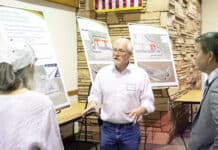In spite of receiving a stern lecture on entitlement law and policy from Bill Ring, a Flagstaff land use attorney, Sedona’s Planning and Zoning Commissioners did not approve Paul Galloway’s Piñon Drive project.
Larson Newspapers
In spite of receiving a stern lecture on entitlement law and policy from Bill Ring, a Flagstaff land use attorney, Sedona’s Planning and Zoning Commissioners did not approve Paul Galloway’s Piñon Drive project.
Ring was brought to the planning and zoning meeting on Tuesday, Dec. 18, by Galloway, who presented revisions to his original plan, which was rejected in November.
The new design for the project calls for eight two-story buildings with a mixture of commercial and residential units totalling 50,000 square feet of commercial space, 23 residential units and 255 parking spaces on 4.6 acres.
Located on a narrow strip of property that borders Hwy. 89A south of Relics restaurant, the project surrounds Juniper Drive and Piñon Drive, small side streets that lead to low-density, heavily treed residential subdivisions.
Beth Escobar, assistant to the director of City Development, recommended approval of the project since it was not found to violate the maximum lot coverage of 25 percent or the maximum square footage of 0.5 floor area ratio.
The developer’s changes since the last review included a reduction of two condos from the original 25, the dissection of one long building into two, relocation of a corner parking lot and the addition of a patio.
During their discussions, the commissioners told Galloway they were looking for a design that offered a more compatible transition from his proposed middle-end business complex to the adjacent private properties, particularly since the only ingress and egress to the existing homes will be through the shopping complex.
However, Ring indicated the current design was unchangeable.
“This is not a zoning case, it is a subdivision case and you are not here to make policy, you are here to interpret ordinances,” Ring told the commissioners. “We have an entitlement of envelope and my client is not willing to reduce it.”
Neighbors also wanted to see further reductions in mass and density.
“We’re not making headway here — you’re just shuffling the buildings around,” Jesse Flores said. “You’ve lost two condos but you’ve increased the commercial space. Plus, for the recreation requirement, you’re now including balconies in that calculation.”
Another neighbor, Brad Luky, also thought the project was overbuilt and worried about resulting pollution in all its forms.
“As a builder myself, I am not against growth, however, I think this project is overbuilt,” Luky said. “I believe there’s inadequate parking for the complex which will lead to sign pollution on our streets.”
“Also, we’ll hear garbage trucks emptying your dumpsters at 4 a.m., outdoor music at the bars and that area will generate light pollution,” Luky said.
Referring to the city’s design review manual item 3.2.2, Commissioner John Griffin brought up the disparity of proportion and scale of the project vis a vis the residential properties that border it.
“This is an important project along our gateway to the city,” Griffin said. “We have to listen to the neighborhood and make this a better project.”
The problem of maximized lot coverages and square footages is a relatively recent one.
“These ratios were set in the early 1990s by a panel of developers, residents and city staff,” Director of City Development John O’Brien said.
“Prior to the dramatic increase in costs of land and construction materials, they worked very well because developers didn’t need to use the maximum square footage to make them work economically,” O’Brien said.
Changing the ratios now is problematic for the city due to new state regulations.
“Proposition 207 was passed by the state last November and this has tied the hands of city governments,” O’Brien said. “Cities in Arizona are no longer allowed to change codes and ordinances that have a [deleterious] economic impact on landowners without compensating them for it.”
The commission voted 4-3 in favor of the continuance with Griffin, Hal Driggs, Denise Barnhart and James Eaton voting for it and Geoff Messer, Marty Losoff and Alex Gillon voting against it.
“Continuances are t ypically used when an applicant has submitted an application that’s incomplete in some way,” Assistant City Attorney Ronald Ramsey said. “For instance, if the applicant is missing a traffic study but everything else is in order, a continuance will be used rather than an approval or a rejection.”
At press time, no date had been set for Galloway’s next appearance before the commission.






















